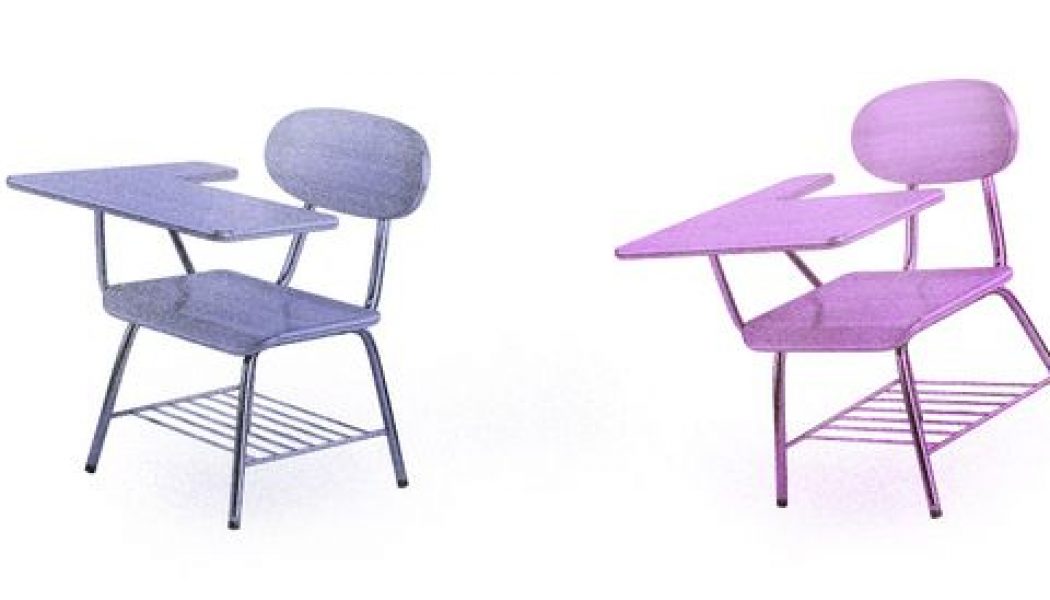A couple of weeks before the first day of school, Amanda received a welcome kit from the Texas high school she’s set to teach theater at this year. The kit included a cloth mask and a face shield — the personal protective equipment (PPE) she’s expected to wear when she spends time on campus this semester. However, neither piece seemed particularly reliable.
“It’s a three-layer cloth mask— it’s not a medical mask — and the face shield looks like it was made by a Booster Club,” Amanda tells The Verge. “But I mean, I’ll take it because I know some of my other teacher friends aren’t receiving PPE at all; they’re having to pay out of pocket to get masks for themselves.”
Amanda officially started teaching classes this week, along with thousands of other teachers across the country. Amanda is not her real name. She didn’t want her name revealed for fear of retribution from her school. “Amanda,” like the names of the other teachers interviewed for this story, is a pseudonym. In her district, the first three weeks will be something of an experiment. All of the students will stay home, while the teachers come onto campus and provide live instruction over Zoom or other videoconferencing tools. That way, the students will still see their teachers inside their classrooms.
But once the first three weeks are up, it’s unclear how her school will move forward. It’s possible the district could extend online learning for a few more weeks or the students may be required to come in full-time. Regardless of what happens, Amanda feels conflicted about what’s to come. “I’m one of those teachers that gets sick anytime a kid gets sick,” she says. “I’m not immunocompromised, but I do catch what the kids bring. I get the flu like every other year. So it’s just a lot on my mind of trying to be like, ‘Oh yeah, I’m excited for this school year,’ which I am. But also, I don’t want to get sick; I don’t want any of my students to get sick. I don’t want any of my colleagues to get sick and die.”
Across the country, teachers like Amanda are grappling with uncertainty about how they’re going to instruct their students for the bulk of the 2020-2021 school year. The COVID-19 pandemic is still in full swing in the US, and recently, cases have surged in states like Texas, Florida, Arizona, and elsewhere. Many teachers are having to prepare for some form of online learning, while the threat of having to do in-person teaching hangs over their heads. They’re concerned about their own safety, the safety of their families, and the safety of their students.
“The thing I am least worried about, for me personally, is being able to deliver digital instruction effectively,” Kristen, a high school chemistry teacher in Texas, tells The Verge. “I’m maybe 0.5 percent worried about my ability to effectively teach online, and I’m 99.5 percent worried about potentially dying.”
:no_upscale()/cdn.vox-cdn.com/uploads/chorus_asset/file/21767493/acastro_200818_4150_btsTeachers_inline_0001.jpg)
For a long time, the science surrounding kids and COVID-19 was pretty murky. At the onset of the COVID-19 crisis, very few children seemed to contract the disease, leading some experts to wonder if kids were less susceptible to the novel coronavirus. Scientists also had a difficult time studying transmission in children at first, as most schools shifted to online learning in March, when many US states initiated lockdown measures.
But as the pandemic has worn on, a new narrative has emerged. Research has shown that while children are less likely to get severely sick from the virus, they are definitely not immune — and they’re capable of spreading it, too. A recent Centers for Disease Control and Prevention study found that children between the ages of 10 and 19 can spread the virus at the same rate that adults do, after looking at COVID-19 transmission in South Korea. Research published in The Journal of the American Medical Association also revealed that children under the age of five who have contracted mild cases of COVID-19 still have high amounts of the virus’s RNA in their throats. The American Academy of Pediatrics released a report stating that a little more than 97,000 school-aged children tested positive for COVID-19 in the last two weeks of July.
Case studies are emerging, showing what happens when large groups of children gather amid the pandemic. After Israel reopened its schools in May, one Jerusalem high school saw a substantial outbreak of COVID-19, which spread among students, teachers, and others in the community. At one sleepaway summer camp in Georgia, 290 people wound up testing positive for COVID-19 out of nearly 600 campers and staff.
At the same time, debate has raged over reopening schools in the fall. President Donald Trump has been very vocal about his desire for schools to reopen for in-person education, even threatening to withhold federal funding from states where schools remain closed. Ultimately, each state is responsible for deciding how its schools will move forward. Some states are leaving it up to the individual districts to figure out what is best for teachers and students. Some states like Texas are mandating that schools eventually do in-person learning, though the state is allowing districts to conduct online learning for a maximum of eight weeks at first. Other states like Arizona are insisting that at least some students come into school full-time — kids “who need a place to go during the day” — or else districts will not qualify for enhanced funding.
That mandate is affecting the Arizona elementary school where Jessica, a teaching coach, works. This week, around 100 students who require special education, speak English as a second language, have reduced lunches, or are children of essential workers will come to campus. But they won’t be going back to their classrooms like usual. “It’s not like they magically go back to their grade,” Jessica tells The Verge. “They’re all still doing online learning, they’re just doing it at school.” The kids will be split up into various rooms and spaced apart from each other. They’ll then be taught by teachers through a computer screen; the teachers will either be giving instruction from home or in another room on campus. Meanwhile, chaperones will watch over the students to make sure no one is getting into trouble and help any kids who have questions.
The setup has led to a lot of stressed-out teachers, according to Jessica. Not only do instructors have anxiety about somehow contracting the virus at school, but they’ve also had to completely shift to online learning, using new platforms like Canvas and Teams. That means many teachers are spending a lot more energy figuring out how to work new technologies and adapt their curriculum, rather than focusing on the content they’re teaching.
Fortunately, Jessica’s school is letting teachers choose to teach from home for now if they’re uncomfortable, so she’s been avoiding going onto campus as much as possible. With two young babies at home, she’s worried about bringing the virus home to her children. “Not everybody has the same level of fear or necessity in terms of wearing a mask,” she says. “You might walk into a room and then they just stay unmasked and continue to talk to you or get closer to you or try to hand you stuff, and I just feel anxious.”
Still, she says she has mixed feelings about the school year. While she doesn’t think it’s a good idea to bring any children on campus during the pandemic, she still worries about those high-risk children who do rely on the school as a stable place away from home. Jessica notes that the free and reduced lunches the school provides are critical for some kids, and teachers will even send meals home with certain students over the weekend. “Yes I’m really worried about bringing stuff home to my kids, but I’m also really worried about the kids that keep us up at night,” she says.
:no_upscale()/cdn.vox-cdn.com/uploads/chorus_asset/file/21767494/acastro_200818_4150_btsTeachers_inline_0002.jpg)
For other teachers, the future of teaching is still uncertain. Less than two weeks before the first day of school was set to begin, Dan and other teachers in his district in Columbus, Ohio, still didn’t know what teaching was going to look like for the school year. His district was waffling between different scenarios, ranging from total online learning to having teachers and students come on campus full-time while wearing masks. District officials also discussed doing a hybrid approach, with teachers and students coming in for only a few days each week and then doing online learning the rest of the week.
It’s made planning for the year incredibly difficult, as the teachers have had to prep for all three possibilities. “Two weeks ago, we were hybrid, then last week were all online and now it’s up in the air again,” Dan, a chemistry and physical education teacher, says. “The school board keeps meeting about it, and I think a lot of us are frustrated. Just make a decision, so we know what to do.”
In Dan’s district, officials tried to make the final decision based on the number of cases and hospitalization metrics within the surrounding community. As the cases have fluctuated, so has the decision about how to proceed. Just a few days before classes began, the district finally decided to do full online learning, as the number of cases in his community are still in the “red” level. Dan thinks it’s the best decision for everyone. “The more I started thinking about it, yeah I don’t really want to roll the dice on going back and being the one in seven adults that will die from it,” he says. “I’m kind of on board with the whole e-learning mode.”
However, the district is eager to move to the hybrid approach when cases come back down. And Dan will still have to teach from on campus during online learning, even with all of the students staying at home. He attributes that decision to a loud contingent of parents who have voiced concerns at board meetings and through social media posts about teachers staying at home to teach. “A lot of the parents in our district are very vocal about: ‘Teachers aren’t going to work; they’re just going to day drink! I want my taxes back’ type of stuff,” he says. “And so, as of right now, the superintendent said that even though the kids are at home, the staff has to report to the building and teach online from your normal classroom… To be honest I was planning on going in a couple times anyways for the labs, but making that mandatory because parents are complaining seems a little more political than I would like.”
For Kristen in Texas, she’s also been experiencing a push from people in her district to make it mandatory for teachers to go onto campus. During one board meeting, a district official tried to argue that teachers would slack off if they stayed home. “This guy says something along the lines of: ‘I just don’t think we can let any teacher teach from home because we need them all in the building — because they might just be taking advantage of it and working at home,’” she says, recounting the argument. “‘We don’t know if they have real disabilities or not. And I see their pictures on Facebook of them at the beach and they just don’t want to work is what it really is.’”
Despite this pressure, Kristen won’t go back to campus right away. Her school will also start with three weeks of online learning before kids and teachers come on campus full-time. When the three weeks are up, all of the teachers will have to come in, though parents can choose to keep their kids home if they want. She says the push to reopen from the district is causing a ton of anxiety because she can’t afford to stop teaching. “I understand that there are families that don’t have much of a choice about sending their children to school, but my family is not going to have a choice about me working or not. We need my income.”
With a young daughter at home, Kristen says she’s come up with an elaborate plan for how she’ll teach at school with students and then come home to her family. “I’m considering buying myself a face shield, and I’m probably going to buy those hair wraps that surgeons wear, because my current plan is to not bring the virus home to my family,” she says. Her principal also gave teachers the okay to wear scrubs and gloves to school, considering it to be professional attire. “So I’m probably going to wear a tank top and some bike shorts under scrubs every day and then in the parking lot, take the gloves off and put them in a bag in my car and then drive home. And then as soon as I get home disinfect my car and strip down and put my clothes in the washer.”
Ultimately, she thinks that if everyone is forced to come onto campus — students and teachers — there will be tragic results. Cases of COVID-19 have increased substantially in her area, and she thinks it’ll only be a matter of time before someone she knows gets sick. “Looking at the current infection rates in my area and knowing the size of my school and knowing the kinds of medically vulnerable coworkers that I have, it’s not a question to me that I am going to know some people who will die from this if school goes back face to face,” she says.
The United States will find out very soon if in-person education leads to more COVID-19 outbreaks. So far, schools that reopened early haven’t had great results. Schools in Georgia’s Cherokee County School District have already been forced to shut down after classes began in early August. Students started testing positive for COVID-19, and now nearly 1,200 people in the county are quarantining. Another nearby Georgia school, North Paulding High School, has also temporarily closed after nine people tested positive following the first week of classes. The school had received national attention after pictures surfaced from inside the campus showing halls of crowded students, many of whom were not wearing masks. More than 2,000 students and teachers in Mississippi are now in quarantine after schools reopened and more than 400 teachers and students tested positive for COVID-19.
Statistically, the students in those schools will probably survive. Fewer than 100 kids under the age of 18 have died from the virus in the United States, according to the CDC. But kids can catch it, and they can spread it. And if children are at school for most of the day, the closest adults nearby will likely be their teachers, older individuals who don’t have as good of odds.
Teachers hope that their districts and lawmakers think about that as the debate over in-person teaching rages on. “Not enough emphasis has been placed on protecting our teachers,” says Amanda from Texas. “If it’s incredibly important for students to be home, teachers should be able to stay home as well.”










